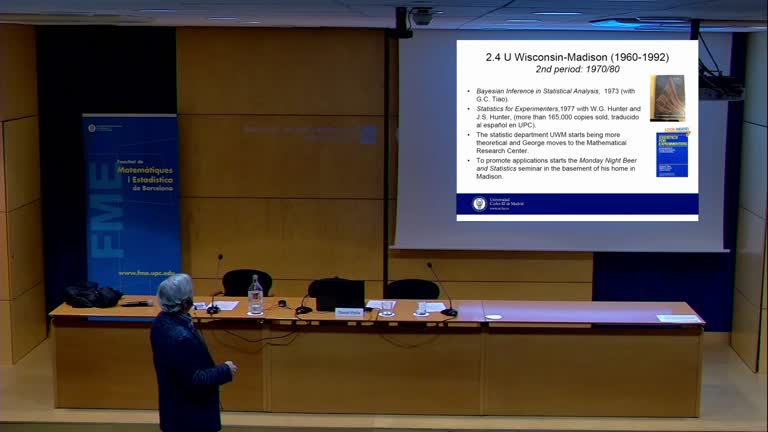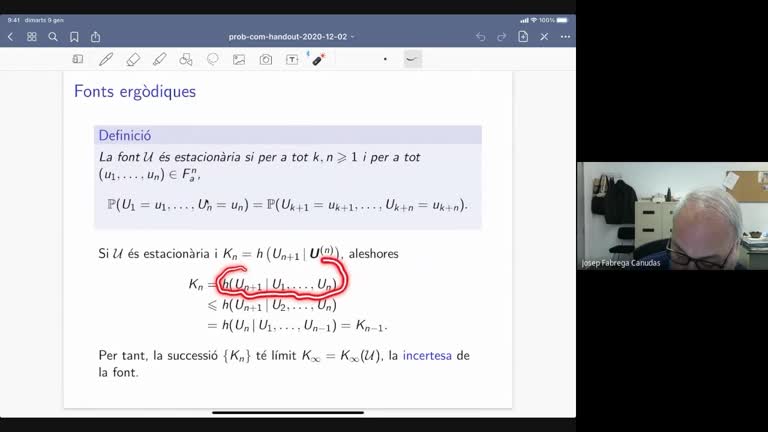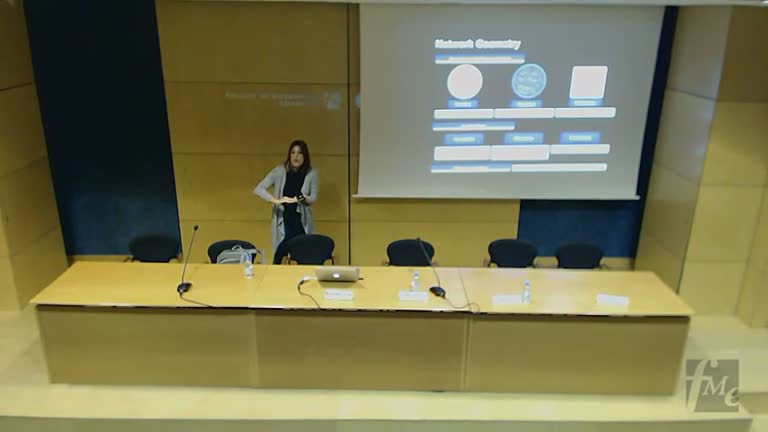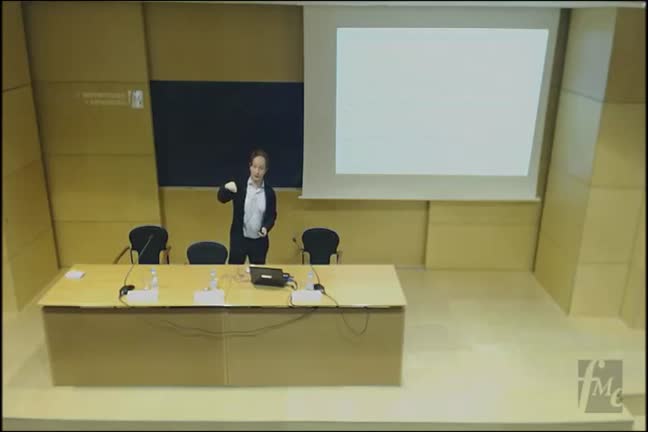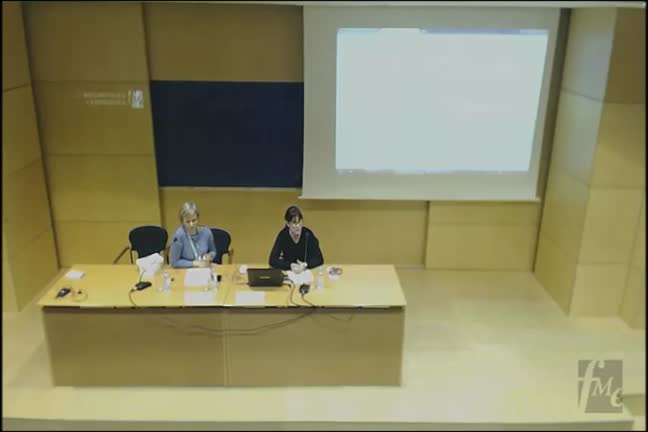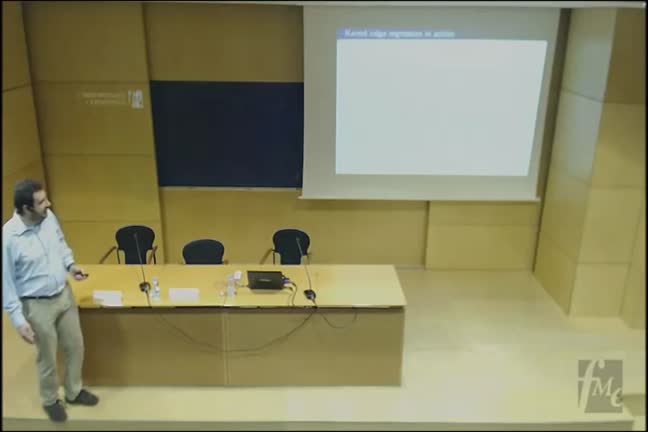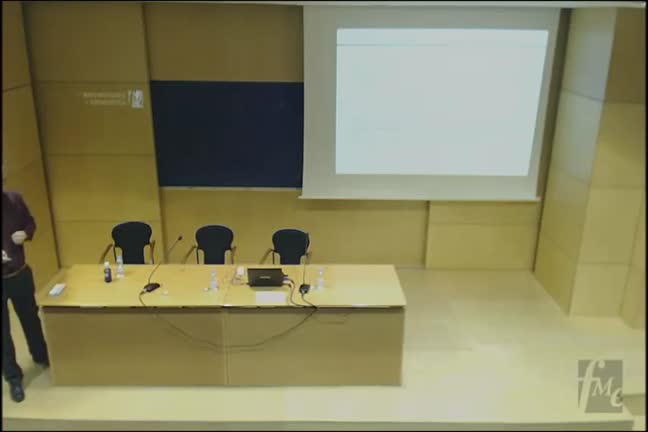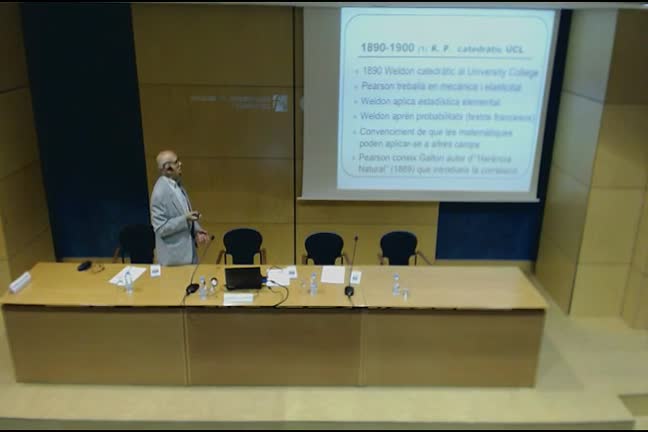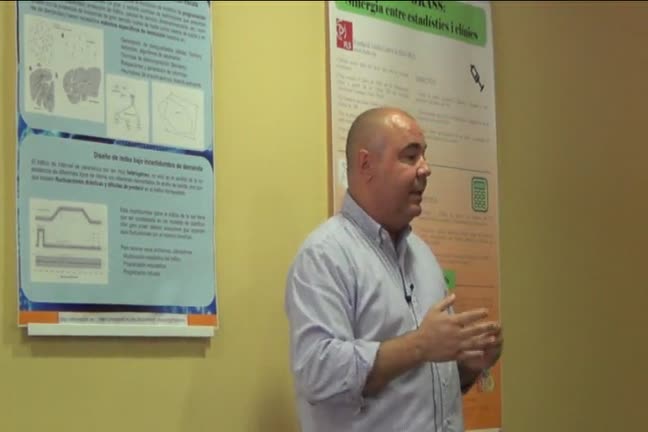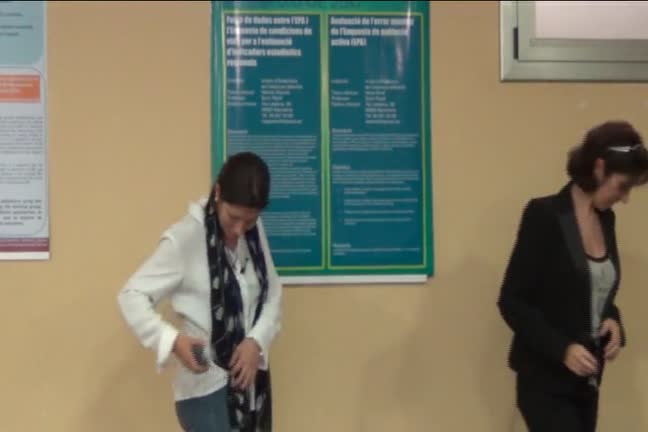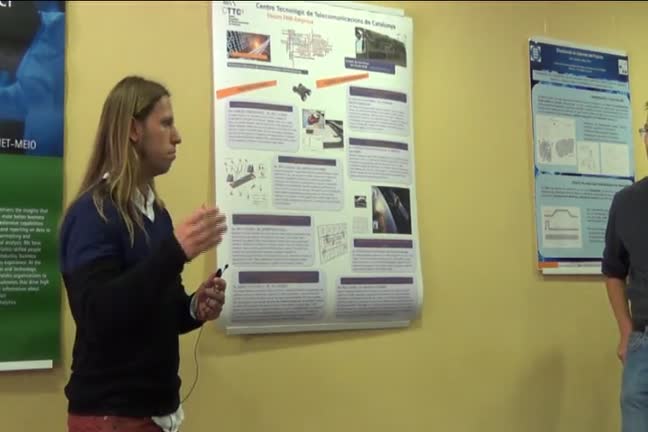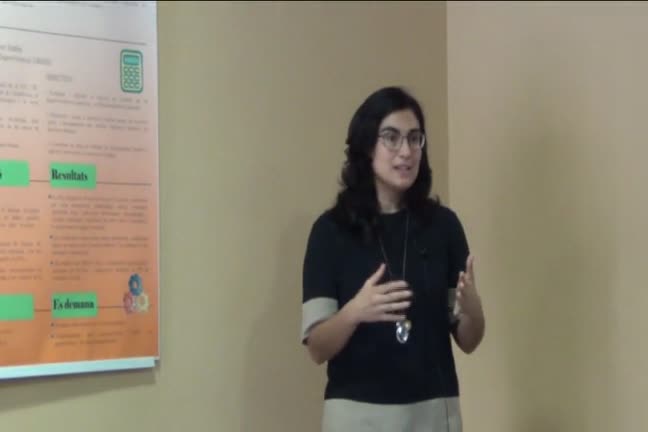Objectes multimèdia amb l’etiqueta: Estadística matemàtica
Resultats de la cerca
Recordando a G.E.P. Box: sus contribuciones y algunas experiencias personales. Jornada Box (2023-2024)
Accés obert
22 de nov. 2023
Daniel Peña, professor emèrit d'Estadística i exrector de la Universidad Carlos III de Madrid (UC3M), co-autor de Box en diverses publicacions i gran coneixedor de la seva obra serà el conferenciant de la jornada. La conferència tindrà lloc dimecres 22 de novembre de 2023 a les 12h30 a la sala d’actes de la Facultat. Daniel Peña, professor emèrit d'Estadística i exrector de la Universidad Carlos III de Madrid (UC3M), co-autor de Box en diverses publicacions i gran coneixedor de la seva obra, serà qui impartirà la ponència amb el títol: “Recordando a G.E.P. Box: Sus contribuciones y algunas experiencias personales” Se revisará la vida de G.E.P. Box y sus contribuciones principales a la estadística, con una mención especial a sus trabajos pioneros en el análisis de datos masivos. Se comentará también su estrecha relación con España y algunas experiencias personales de sus visitas a nuestro país.
Probabilitats i teoria de la comunicació: codificació, caminades aleatòries en grafs i algorismes. (Contextualització de les Matemàtiques a les carreres tecnològiques de la UPC)
Accés obert
2 de des. 2020
Es presentaran a nivell introductori alguns temes de les matemàtiques de les telecomunicacions i de la informació que es poden explicar en els currículums d'alguns dels nostres graus, com ara: taxes de codificació fiables, fonts de Markov i fonts ergòdiques, i camins aleatoris en grafs i xarxes elèctriques. Les probabilitats i les cadenes de Markov seran el nexe per recórrer aquests conceptes.
Network geometry
Accés obert
28 de nov. 2018
M. Ángeles Serrano obtained her Ph.D. in Physics at the Universitat de Barcelona (UB) in 1999 with a thesis about gravitational wave detection. In 2000, she also received her Masters in Mathematics for Finance at the CRM-Universitat Autònoma de Barcelona. After four years in the private sector as IT consultant and mutual funds manager, Prof. Serrano returned to academia in 2004 to work in the field of Network Science. Subsequently, she was a researcher at Indiana University (USA), the École Polytechnique Fédérale de Lausanne (Switzerland), IFISC Institute (Spain), and held a Ramón y Cajal research associate appointment at UB until october 2015. The results of her investigations are summarized in major peer reviewed international scientific journals -including Nature, PNAS, PRL, ...-, book chapters, and conference proceedings. Prof. Serrano leads and participates in several research projects at the international and national levels. She is also actively involved in advising and research supervision. She serves in evaluation panels and program scientific committees, and acts as a reviewer in several international journals. In February 2009, she obtained the Outstanding Referee award of the American Physical Society. She is a Founder Member of Complexitat, the Catalan Network for the study of Complex Systems, and a Promoter Member of UBICS, the Universitat de Barcelona Institute of Complex Systems.
Networks are critical to understand human nature ---from genome to brain and society--- and our environment ---the Internet, food webs, international trade... ---, and are changing the way in which we model and predict complex systems in many different disciplines. Surprisingly, all complex networks talk a common language, regardless of their origin, and are imprinted with universal features. They are small-world, strongly clustered and hierarchical, modular, robust yet fragile, and may exhibit unexpected responses like cascades and other critical and extreme events.
Many of these fundamental properties are well explained by a family of hidden metric space network models that led to the discovery that the latent geometry of many real networks is hyperbolic. Hyperbolicity emerges as a result of the combination of popularity and similarity dimensions into an effective distance between nodes, such that more popular and similar nodes have more chance to interact. The geometric approach permits the production of truly cartographic maps of real networks that are not only visually appealing, but enable applications like efficient navigation and the detection of communities of similar nodes. Recently, it has also enabled the introduction of a geometric renormalization group that unravels the multiple length scales coexisting in complex networks, strongly intertwined due to their small world property.
Interestingly, real-world scale-free networks are self-similar when observed at the different resolutions unfolded by geometric renormalization, a property that might find its origin in an evolutionary drive. Practical applications of the geometric renormalization group for networks include high-fidelity downscaled network replicas, a multiscale navigation protocol in hyperbolic space that takes advantage of the increased navigation efficiency at higher scales, and many others.
Networks are critical to understand human nature ---from genome to brain and society--- and our environment ---the Internet, food webs, international trade... ---, and are changing the way in which we model and predict complex systems in many different disciplines. Surprisingly, all complex networks talk a common language, regardless of their origin, and are imprinted with universal features. They are small-world, strongly clustered and hierarchical, modular, robust yet fragile, and may exhibit unexpected responses like cascades and other critical and extreme events.
Many of these fundamental properties are well explained by a family of hidden metric space network models that led to the discovery that the latent geometry of many real networks is hyperbolic. Hyperbolicity emerges as a result of the combination of popularity and similarity dimensions into an effective distance between nodes, such that more popular and similar nodes have more chance to interact. The geometric approach permits the production of truly cartographic maps of real networks that are not only visually appealing, but enable applications like efficient navigation and the detection of communities of similar nodes. Recently, it has also enabled the introduction of a geometric renormalization group that unravels the multiple length scales coexisting in complex networks, strongly intertwined due to their small world property.
Interestingly, real-world scale-free networks are self-similar when observed at the different resolutions unfolded by geometric renormalization, a property that might find its origin in an evolutionary drive. Practical applications of the geometric renormalization group for networks include high-fidelity downscaled network replicas, a multiscale navigation protocol in hyperbolic space that takes advantage of the increased navigation efficiency at higher scales, and many others.
Correlación lineal y correlación de distancias. Jornada Pearson (Curs 2016-2017)
Accés obert
8 de març 2017
La mayoría de los científicos ha calculado alguna vez el coeficiente de correlación de Pearson para cuantificar el grado de asociación lineal entre dos variables. Aunque es una medida muy sencilla y útil, la correlación de Pearson no siempre es efectiva para detectar relaciones no lineales entre las variables. En esta charla se presentará una medida alternativa, la correlación de distancias, propuesta por Székely, Rizzo y Bakirov en un influyente artículo publicado en 2007. La correlación de distancias es una coeficiente relativamente sFoto_Berrenderoimple y bastante eficaz para detectar relaciones no lineales entre variables. Se comentarán sus ventajas e inconvenientes, en comparación con los de la correlación lineal, así como sus aplicaciones en diversos problemas estadísticos.
Lliurament premis als guanyadors del Concurs Pearson. Jornada Pearson (Curs 2016-2017)
Accés obert
8 de març 2017
Lliurament de premis als guanyadors del Concurs Pearson, activitat conjunta de l’assignatura Història de la Matemàtica, la Biblioteca FME i la col·laboració de la Cap d'Estudis d'Estadística.
Els mètodes kernel i perquè els hauríem d'estimar. Jornada Pearson (Curs 2016-2017)
Accés obert
8 de març 2017
Molts problemes d'aprenentatge automàtic es poden formular com problemes clàssics de l'estadística multivariant; per exemple, el reconeixement de patrons, la regressió o la reducció de la dimensió. Cada cop és més freqüent que els problemes vinguin descrits per dades que no segueixen la representació clàssica de vectors de nombres reals. Per exemple, seqüències de proteïnes, documents de text i XML, imatges, grafs o sèries de temps són comunes en biologia computacional, text mining, web mining, en el reconeixement de veu, etc.
Els mètodes kernel són una classe d'algorismes que estenen l'aplicabilitat de molts mètodes estadístics a pràcticament qualsevol tipus de dades, sense la necessitat de vectorització o codificació explícita. També tenen la virtut de convertir un mètode fonamentalment lineal en un de no lineal, subjecte a certes condicions d'EFoto_belancheuclidianitat. En aquesta xerrada s'ofereix una panoràmica dels mètodes kernel i s'il·lustra el seu potencial aplicant-les a algunes de les tècniques de l'estadística multivariant: regressió lineal, PCA i MDS.
Els mètodes kernel són una classe d'algorismes que estenen l'aplicabilitat de molts mètodes estadístics a pràcticament qualsevol tipus de dades, sense la necessitat de vectorització o codificació explícita. També tenen la virtut de convertir un mètode fonamentalment lineal en un de no lineal, subjecte a certes condicions d'EFoto_belancheuclidianitat. En aquesta xerrada s'ofereix una panoràmica dels mètodes kernel i s'il·lustra el seu potencial aplicant-les a algunes de les tècniques de l'estadística multivariant: regressió lineal, PCA i MDS.
Un updated review of Goodness-of-Fit test for regression models with some recent results. Jornada Pearson (Curs 2016-2017)
Accés obert
8 de març 2017
The term Goodness–of–Fit (Gof) was introduced by Pearson at the beginning of the last century and refers to statistical tests which check how a distribution fits to a data set in a omnibus way. Since then, many papers were devoted to the χ2 test, the Kolmogorov-Smirnov test and other related methods. The pilot function used for testing was mainly the empirical distribution function. In the last twenty five years, there has been an explosion of works that extended the GoF ideas to other types of functions: density function, regression function, hazard rate function and intensity function.
In this talk, we will give a modern review approach for the GoF theory, illustrating applica- tions in topics of great interest and showing some advances with recent results in (a) testing for interest rate models, (b) testing with directional data and (c) testing for regression with functional covariables.
In this talk, we will give a modern review approach for the GoF theory, illustrating applica- tions in topics of great interest and showing some advances with recent results in (a) testing for interest rate models, (b) testing with directional data and (c) testing for regression with functional covariables.
Karl Pearson, fundador de l’estadística moderna. Lliçó inaugural Curs Pearson (2016-2017)
Accés obert
28 de set. 2016
El matemàtic K. Pearson, pare de l’estadística tal com l’entenem avui dia, va ser un científic i pensador bastant polifacètic. Tot i que treballava en matemàtica aplicada, mecànica, elasticitat, teoria de l’evolució, i sovint escrivia sobre història i filosofia, el contacte amb biòlegs el va decantar cap a l’estadística descriptiva i poc després cap a l’estadística matemàtica, que ell mateix va fundar. Les seves aportacions a la correlació i regressió, la prova khi-quadrat, l’anàlisi de components principals, el coeficient de semblança racial, són de gran importància. Per glossar la seva personalitat, es fa una exposició de les seves aportacions, relacionant-les amb altres descobriments de l’època. Es comenten també alguns aspectes polèmics (eugenèsia, controvèrsies amb Fisher i Neyman). Finalment es fa una breu exposició de la història del coeficient de correlació des de 1846 fins 2015.


